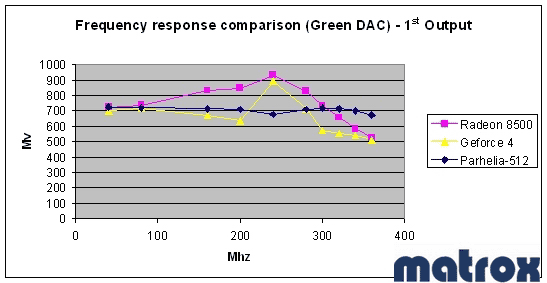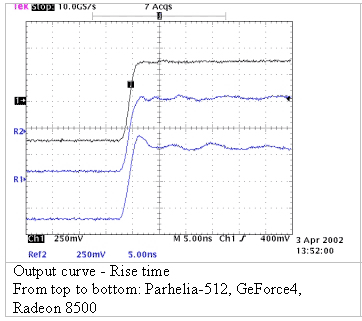Matrox's Comeback Kid - The Parhelia-512
by Anand Lal Shimpi on May 14, 2002 9:00 AM EST- Posted in
- GPUs
Parhelia vs. GeForce4 vs. Radeon 8500 - Image Quality
Matrox has performed some of their own tests on the Parhelia's analog signal output in comparison to a PNY GeForce4 and an ATI Radeon 8500 card. The results are very interesting:
You can use this table to help you understand what frequencies various resolutions correspond to:
|
Signal
Frequencies for Resolutions @ 85Hz
|
||||||
|
Resolution
|
Frequency
|
|||||
|
640x480
|
37MHz
|
|||||
|
800x600
|
58MHz
|
|||||
|
1024x768
|
95MHz
|
|||||
|
1280x1024
|
159MHz
|
|||||
|
1600x1200
|
233MHz
|
|||||
|
1920x1440
|
336MHz
|
|||||
|
2048x1536
|
382MHz
|
|||||

Here you can see that both the GeForce4 and the Radeon 8500 do not exhibit a uniform voltage at all of the frequencies. It is important to note that since there seems to be an amplification of the output voltage this graph isn't entirely the result of a poorly designed low-pass filter circuit on the Radeon 8500 and GeForce4 cards. It could very well be that in order to attempt to compensate for cheaper filter circuitry the RAMDACs output higher voltages at higher frequencies on purpose. The point to take away from this chart is that the Parhelia's voltage output remains relatively constant regardless of frequency. But this doesn't tell you much about image quality, luckily Matrox provided some other interesting graphs:

This graph shows the transient rise time of the three cards; what you should look for here is how long it takes the voltage to settle once it has reached the appropriate voltage level. The Parhelia-512 card settles almost immediately, while the Radeon 8500 never really recovers after its initial overshoot. A non-stable signal here will result in blurry text at these high resolutions.
We're going to try and reproduce Matrox's results on our own for the entire line of ATI and NVIDIA cards we have in house to do a true image quality comparison among video cards for a future article.










0 Comments
View All Comments